Business Management Report: Unilever's Spanish Market Launch Strategy
VerifiedAdded on 2023/06/04
|7
|1368
|115
Report
AI Summary
This report provides a strategic analysis of Unilever's new product launch in Spain, focusing on competitor analysis using Porter's Diamond model. The report examines Unilever's competitive advantages, including its multinational presence, skilled workforce, and favorable demand conditions. It also assesses the role of government and chance in Unilever's favor within the Spanish market. Key competitors like Procter & Gamble and Nestle are compared. The report highlights Unilever's advantages, such as its existing partnerships and the government's supportive stance. A price table illustrates Unilever's competitive pricing. The conclusion recommends production diversification and strategic alliances for improved business performance. The analysis underscores Unilever's strong position in the Spanish market and offers strategic recommendations for continued success.
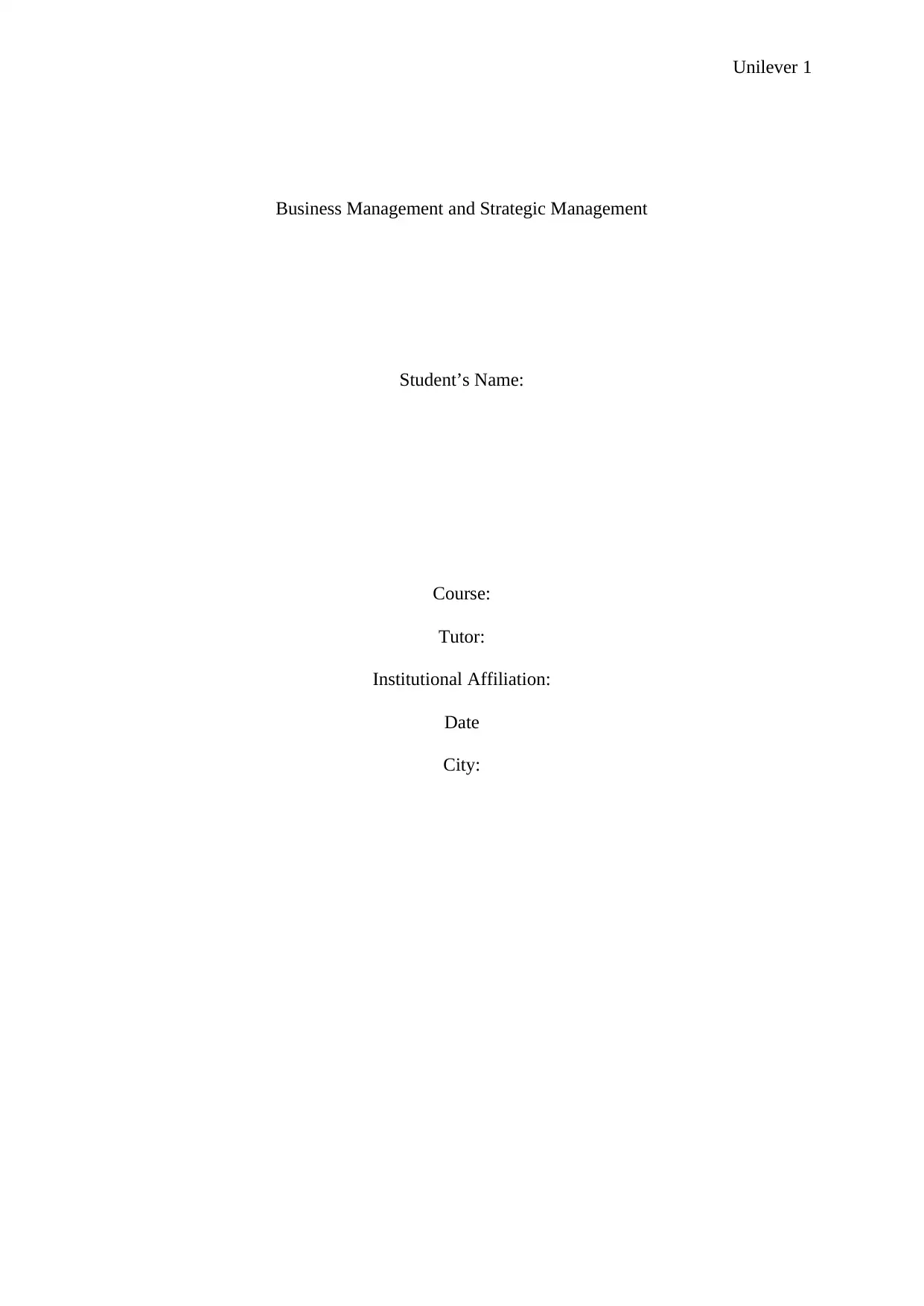
Unilever 1
Business Management and Strategic Management
Student’s Name:
Course:
Tutor:
Institutional Affiliation:
Date
City:
Business Management and Strategic Management
Student’s Name:
Course:
Tutor:
Institutional Affiliation:
Date
City:
Paraphrase This Document
Need a fresh take? Get an instant paraphrase of this document with our AI Paraphraser
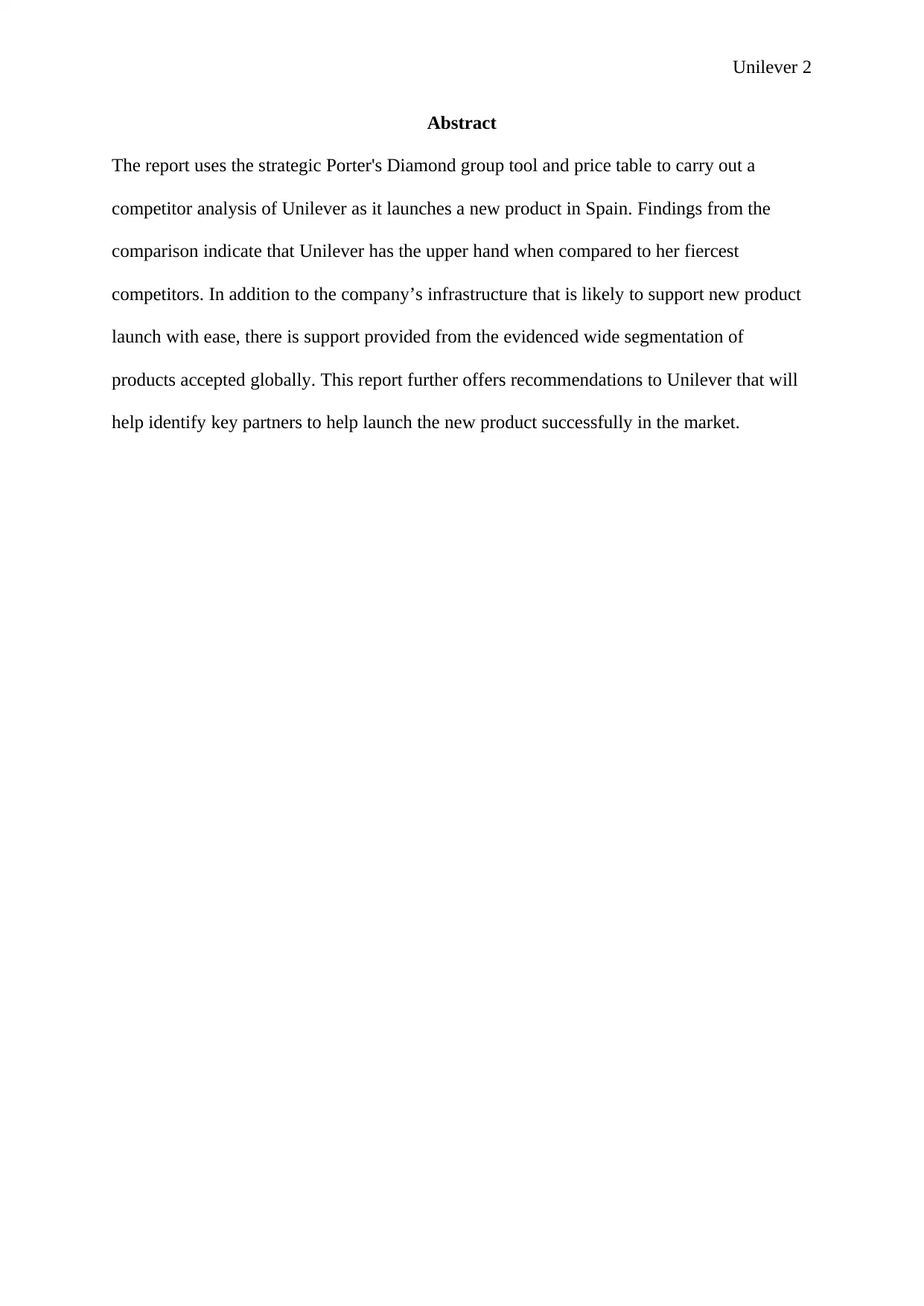
Unilever 2
Abstract
The report uses the strategic Porter's Diamond group tool and price table to carry out a
competitor analysis of Unilever as it launches a new product in Spain. Findings from the
comparison indicate that Unilever has the upper hand when compared to her fiercest
competitors. In addition to the company’s infrastructure that is likely to support new product
launch with ease, there is support provided from the evidenced wide segmentation of
products accepted globally. This report further offers recommendations to Unilever that will
help identify key partners to help launch the new product successfully in the market.
Abstract
The report uses the strategic Porter's Diamond group tool and price table to carry out a
competitor analysis of Unilever as it launches a new product in Spain. Findings from the
comparison indicate that Unilever has the upper hand when compared to her fiercest
competitors. In addition to the company’s infrastructure that is likely to support new product
launch with ease, there is support provided from the evidenced wide segmentation of
products accepted globally. This report further offers recommendations to Unilever that will
help identify key partners to help launch the new product successfully in the market.
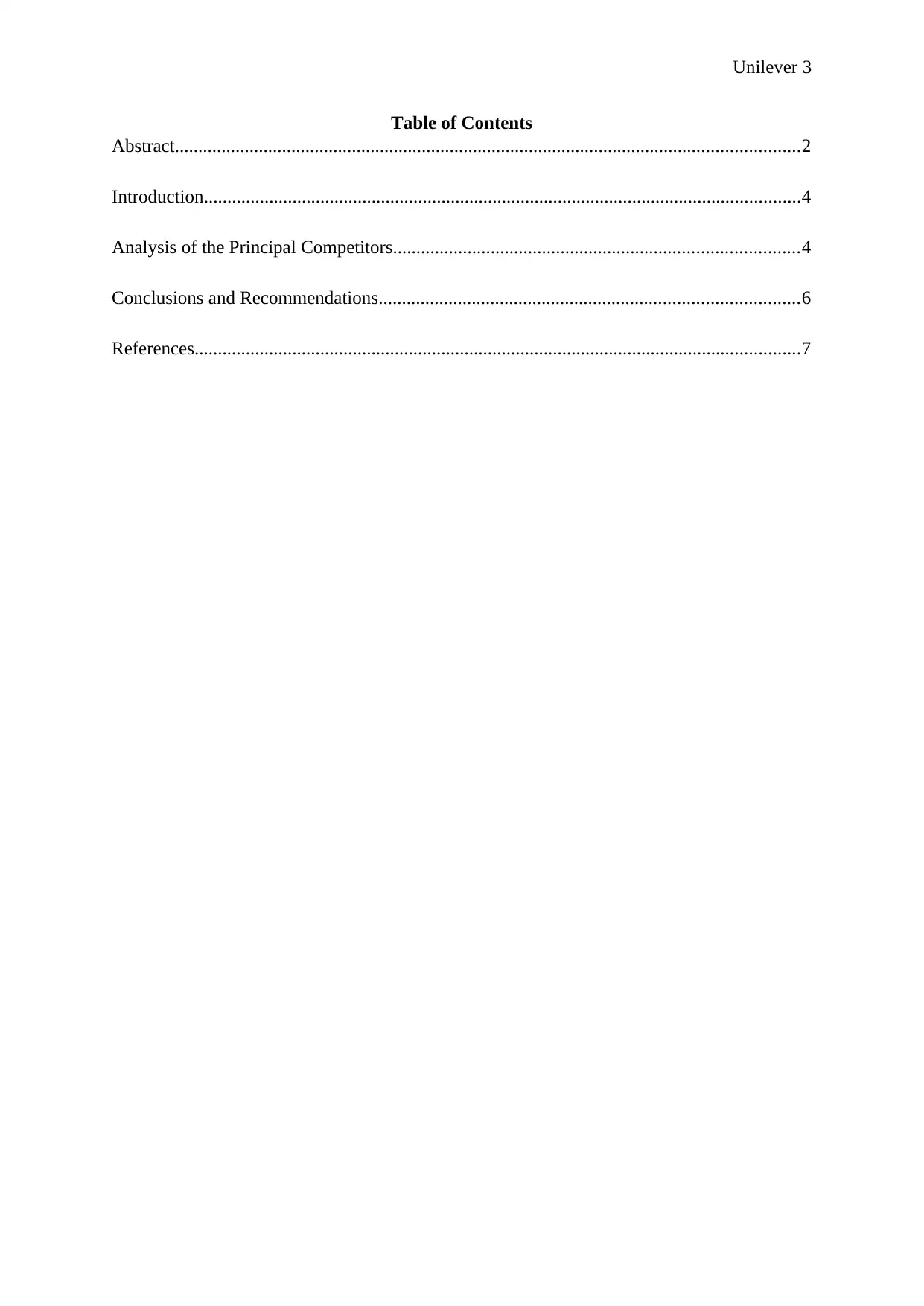
Unilever 3
Table of Contents
Abstract......................................................................................................................................2
Introduction................................................................................................................................4
Analysis of the Principal Competitors.......................................................................................4
Conclusions and Recommendations..........................................................................................6
References..................................................................................................................................7
Table of Contents
Abstract......................................................................................................................................2
Introduction................................................................................................................................4
Analysis of the Principal Competitors.......................................................................................4
Conclusions and Recommendations..........................................................................................6
References..................................................................................................................................7
⊘ This is a preview!⊘
Do you want full access?
Subscribe today to unlock all pages.

Trusted by 1+ million students worldwide
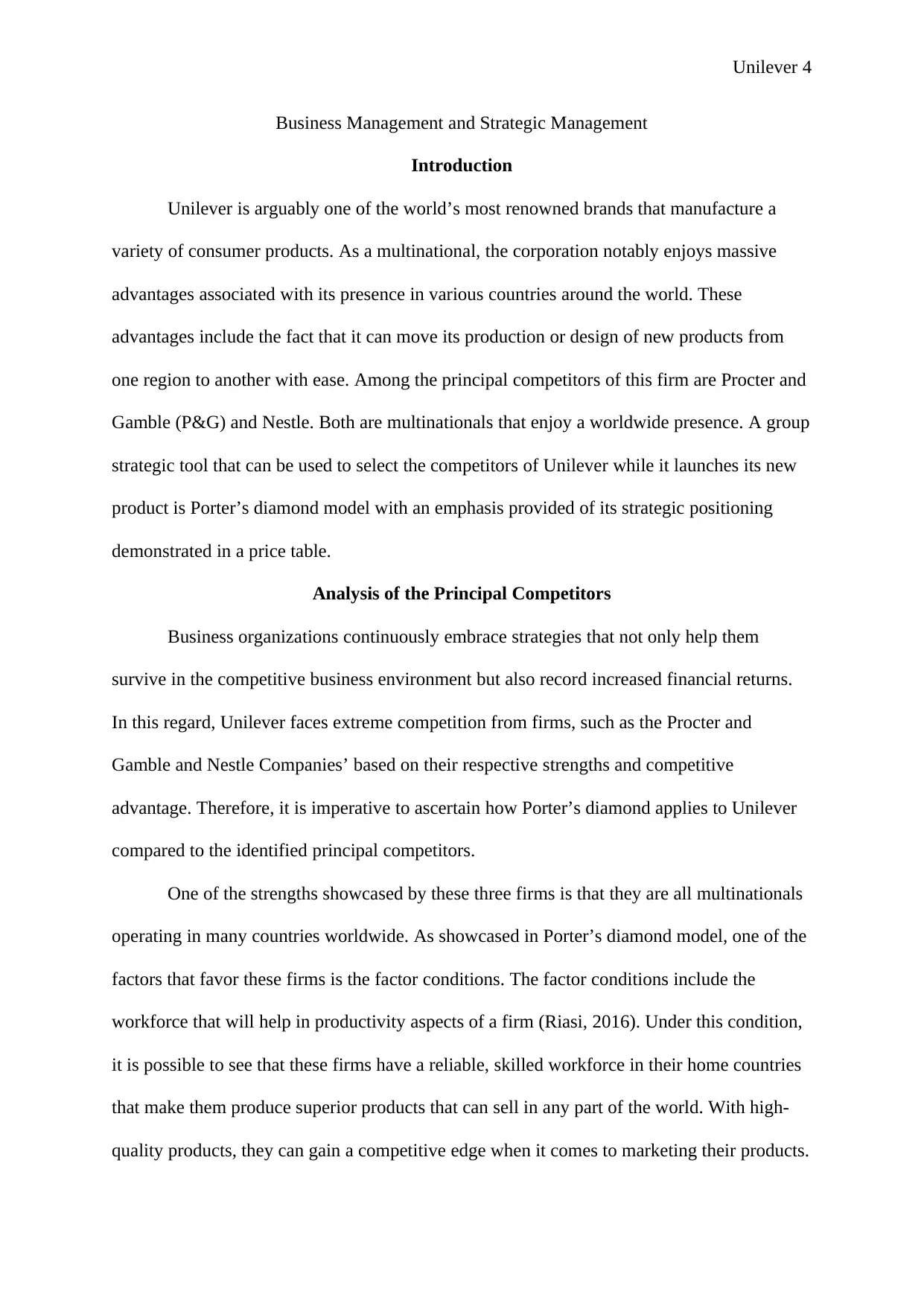
Unilever 4
Business Management and Strategic Management
Introduction
Unilever is arguably one of the world’s most renowned brands that manufacture a
variety of consumer products. As a multinational, the corporation notably enjoys massive
advantages associated with its presence in various countries around the world. These
advantages include the fact that it can move its production or design of new products from
one region to another with ease. Among the principal competitors of this firm are Procter and
Gamble (P&G) and Nestle. Both are multinationals that enjoy a worldwide presence. A group
strategic tool that can be used to select the competitors of Unilever while it launches its new
product is Porter’s diamond model with an emphasis provided of its strategic positioning
demonstrated in a price table.
Analysis of the Principal Competitors
Business organizations continuously embrace strategies that not only help them
survive in the competitive business environment but also record increased financial returns.
In this regard, Unilever faces extreme competition from firms, such as the Procter and
Gamble and Nestle Companies’ based on their respective strengths and competitive
advantage. Therefore, it is imperative to ascertain how Porter’s diamond applies to Unilever
compared to the identified principal competitors.
One of the strengths showcased by these three firms is that they are all multinationals
operating in many countries worldwide. As showcased in Porter’s diamond model, one of the
factors that favor these firms is the factor conditions. The factor conditions include the
workforce that will help in productivity aspects of a firm (Riasi, 2016). Under this condition,
it is possible to see that these firms have a reliable, skilled workforce in their home countries
that make them produce superior products that can sell in any part of the world. With high-
quality products, they can gain a competitive edge when it comes to marketing their products.
Business Management and Strategic Management
Introduction
Unilever is arguably one of the world’s most renowned brands that manufacture a
variety of consumer products. As a multinational, the corporation notably enjoys massive
advantages associated with its presence in various countries around the world. These
advantages include the fact that it can move its production or design of new products from
one region to another with ease. Among the principal competitors of this firm are Procter and
Gamble (P&G) and Nestle. Both are multinationals that enjoy a worldwide presence. A group
strategic tool that can be used to select the competitors of Unilever while it launches its new
product is Porter’s diamond model with an emphasis provided of its strategic positioning
demonstrated in a price table.
Analysis of the Principal Competitors
Business organizations continuously embrace strategies that not only help them
survive in the competitive business environment but also record increased financial returns.
In this regard, Unilever faces extreme competition from firms, such as the Procter and
Gamble and Nestle Companies’ based on their respective strengths and competitive
advantage. Therefore, it is imperative to ascertain how Porter’s diamond applies to Unilever
compared to the identified principal competitors.
One of the strengths showcased by these three firms is that they are all multinationals
operating in many countries worldwide. As showcased in Porter’s diamond model, one of the
factors that favor these firms is the factor conditions. The factor conditions include the
workforce that will help in productivity aspects of a firm (Riasi, 2016). Under this condition,
it is possible to see that these firms have a reliable, skilled workforce in their home countries
that make them produce superior products that can sell in any part of the world. With high-
quality products, they can gain a competitive edge when it comes to marketing their products.
Paraphrase This Document
Need a fresh take? Get an instant paraphrase of this document with our AI Paraphraser
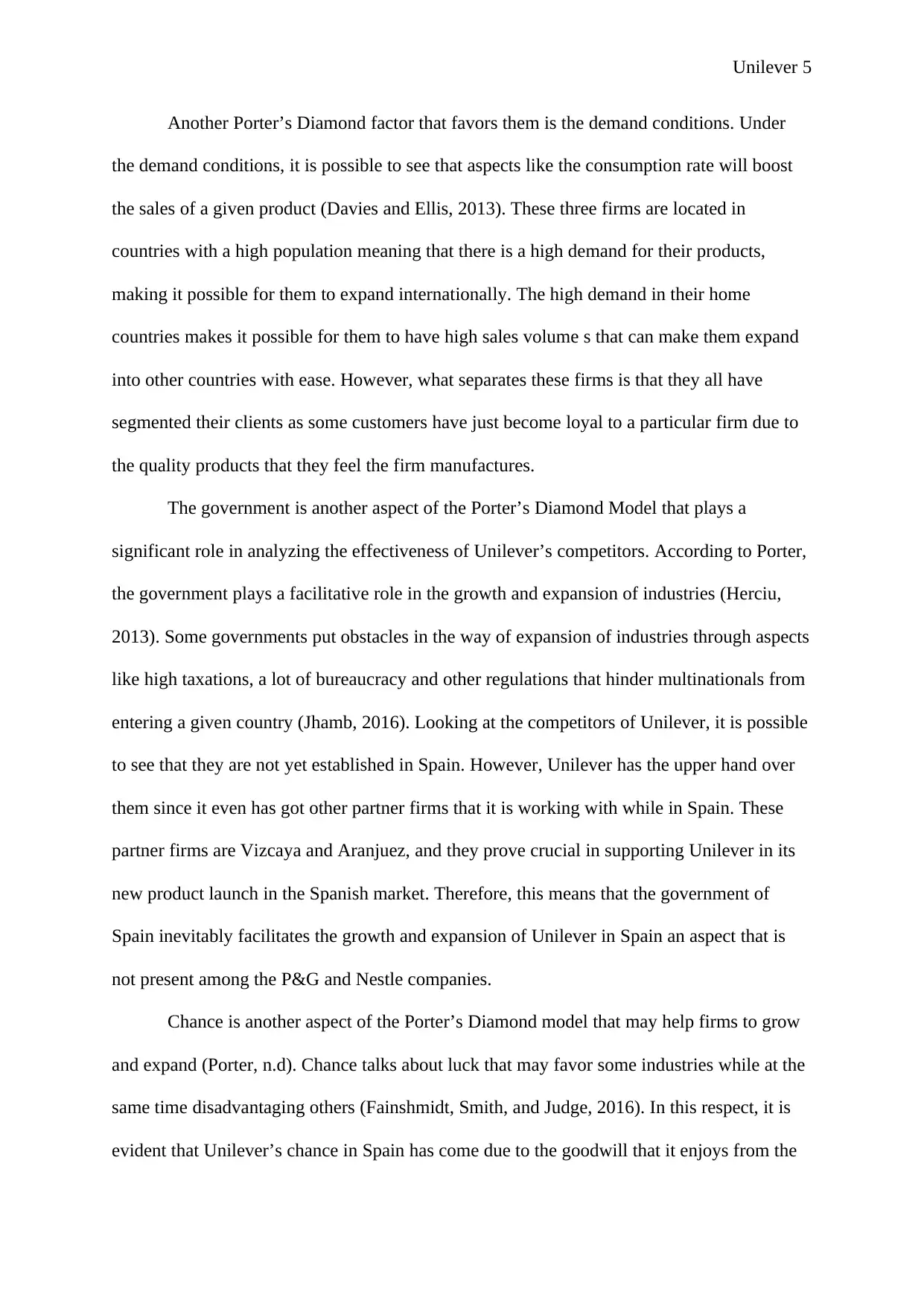
Unilever 5
Another Porter’s Diamond factor that favors them is the demand conditions. Under
the demand conditions, it is possible to see that aspects like the consumption rate will boost
the sales of a given product (Davies and Ellis, 2013). These three firms are located in
countries with a high population meaning that there is a high demand for their products,
making it possible for them to expand internationally. The high demand in their home
countries makes it possible for them to have high sales volume s that can make them expand
into other countries with ease. However, what separates these firms is that they all have
segmented their clients as some customers have just become loyal to a particular firm due to
the quality products that they feel the firm manufactures.
The government is another aspect of the Porter’s Diamond Model that plays a
significant role in analyzing the effectiveness of Unilever’s competitors. According to Porter,
the government plays a facilitative role in the growth and expansion of industries (Herciu,
2013). Some governments put obstacles in the way of expansion of industries through aspects
like high taxations, a lot of bureaucracy and other regulations that hinder multinationals from
entering a given country (Jhamb, 2016). Looking at the competitors of Unilever, it is possible
to see that they are not yet established in Spain. However, Unilever has the upper hand over
them since it even has got other partner firms that it is working with while in Spain. These
partner firms are Vizcaya and Aranjuez, and they prove crucial in supporting Unilever in its
new product launch in the Spanish market. Therefore, this means that the government of
Spain inevitably facilitates the growth and expansion of Unilever in Spain an aspect that is
not present among the P&G and Nestle companies.
Chance is another aspect of the Porter’s Diamond model that may help firms to grow
and expand (Porter, n.d). Chance talks about luck that may favor some industries while at the
same time disadvantaging others (Fainshmidt, Smith, and Judge, 2016). In this respect, it is
evident that Unilever’s chance in Spain has come due to the goodwill that it enjoys from the
Another Porter’s Diamond factor that favors them is the demand conditions. Under
the demand conditions, it is possible to see that aspects like the consumption rate will boost
the sales of a given product (Davies and Ellis, 2013). These three firms are located in
countries with a high population meaning that there is a high demand for their products,
making it possible for them to expand internationally. The high demand in their home
countries makes it possible for them to have high sales volume s that can make them expand
into other countries with ease. However, what separates these firms is that they all have
segmented their clients as some customers have just become loyal to a particular firm due to
the quality products that they feel the firm manufactures.
The government is another aspect of the Porter’s Diamond Model that plays a
significant role in analyzing the effectiveness of Unilever’s competitors. According to Porter,
the government plays a facilitative role in the growth and expansion of industries (Herciu,
2013). Some governments put obstacles in the way of expansion of industries through aspects
like high taxations, a lot of bureaucracy and other regulations that hinder multinationals from
entering a given country (Jhamb, 2016). Looking at the competitors of Unilever, it is possible
to see that they are not yet established in Spain. However, Unilever has the upper hand over
them since it even has got other partner firms that it is working with while in Spain. These
partner firms are Vizcaya and Aranjuez, and they prove crucial in supporting Unilever in its
new product launch in the Spanish market. Therefore, this means that the government of
Spain inevitably facilitates the growth and expansion of Unilever in Spain an aspect that is
not present among the P&G and Nestle companies.
Chance is another aspect of the Porter’s Diamond model that may help firms to grow
and expand (Porter, n.d). Chance talks about luck that may favor some industries while at the
same time disadvantaging others (Fainshmidt, Smith, and Judge, 2016). In this respect, it is
evident that Unilever’s chance in Spain has come due to the goodwill that it enjoys from the
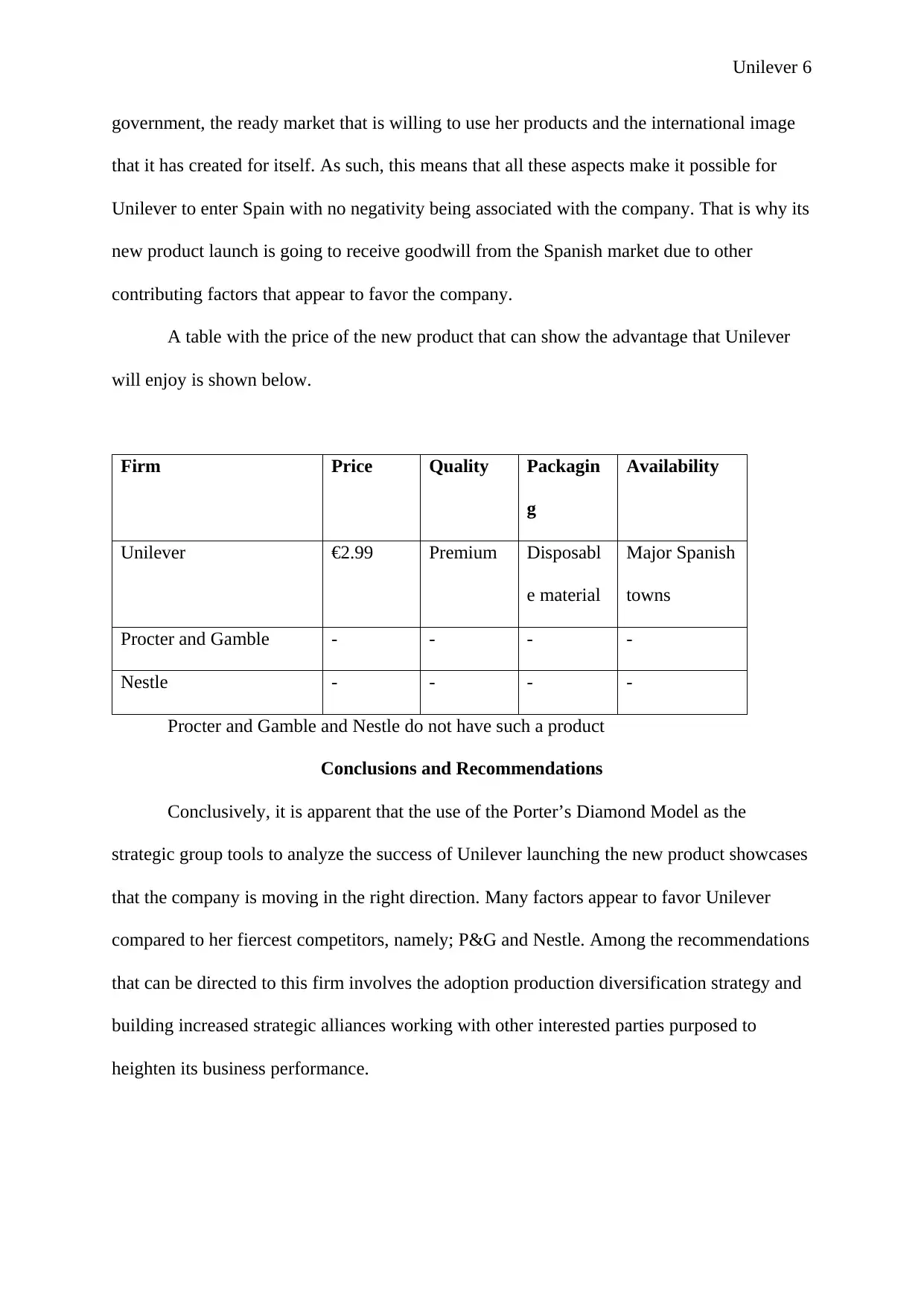
Unilever 6
government, the ready market that is willing to use her products and the international image
that it has created for itself. As such, this means that all these aspects make it possible for
Unilever to enter Spain with no negativity being associated with the company. That is why its
new product launch is going to receive goodwill from the Spanish market due to other
contributing factors that appear to favor the company.
A table with the price of the new product that can show the advantage that Unilever
will enjoy is shown below.
Firm Price Quality Packagin
g
Availability
Unilever €2.99 Premium Disposabl
e material
Major Spanish
towns
Procter and Gamble - - - -
Nestle - - - -
Procter and Gamble and Nestle do not have such a product
Conclusions and Recommendations
Conclusively, it is apparent that the use of the Porter’s Diamond Model as the
strategic group tools to analyze the success of Unilever launching the new product showcases
that the company is moving in the right direction. Many factors appear to favor Unilever
compared to her fiercest competitors, namely; P&G and Nestle. Among the recommendations
that can be directed to this firm involves the adoption production diversification strategy and
building increased strategic alliances working with other interested parties purposed to
heighten its business performance.
government, the ready market that is willing to use her products and the international image
that it has created for itself. As such, this means that all these aspects make it possible for
Unilever to enter Spain with no negativity being associated with the company. That is why its
new product launch is going to receive goodwill from the Spanish market due to other
contributing factors that appear to favor the company.
A table with the price of the new product that can show the advantage that Unilever
will enjoy is shown below.
Firm Price Quality Packagin
g
Availability
Unilever €2.99 Premium Disposabl
e material
Major Spanish
towns
Procter and Gamble - - - -
Nestle - - - -
Procter and Gamble and Nestle do not have such a product
Conclusions and Recommendations
Conclusively, it is apparent that the use of the Porter’s Diamond Model as the
strategic group tools to analyze the success of Unilever launching the new product showcases
that the company is moving in the right direction. Many factors appear to favor Unilever
compared to her fiercest competitors, namely; P&G and Nestle. Among the recommendations
that can be directed to this firm involves the adoption production diversification strategy and
building increased strategic alliances working with other interested parties purposed to
heighten its business performance.
⊘ This is a preview!⊘
Do you want full access?
Subscribe today to unlock all pages.

Trusted by 1+ million students worldwide
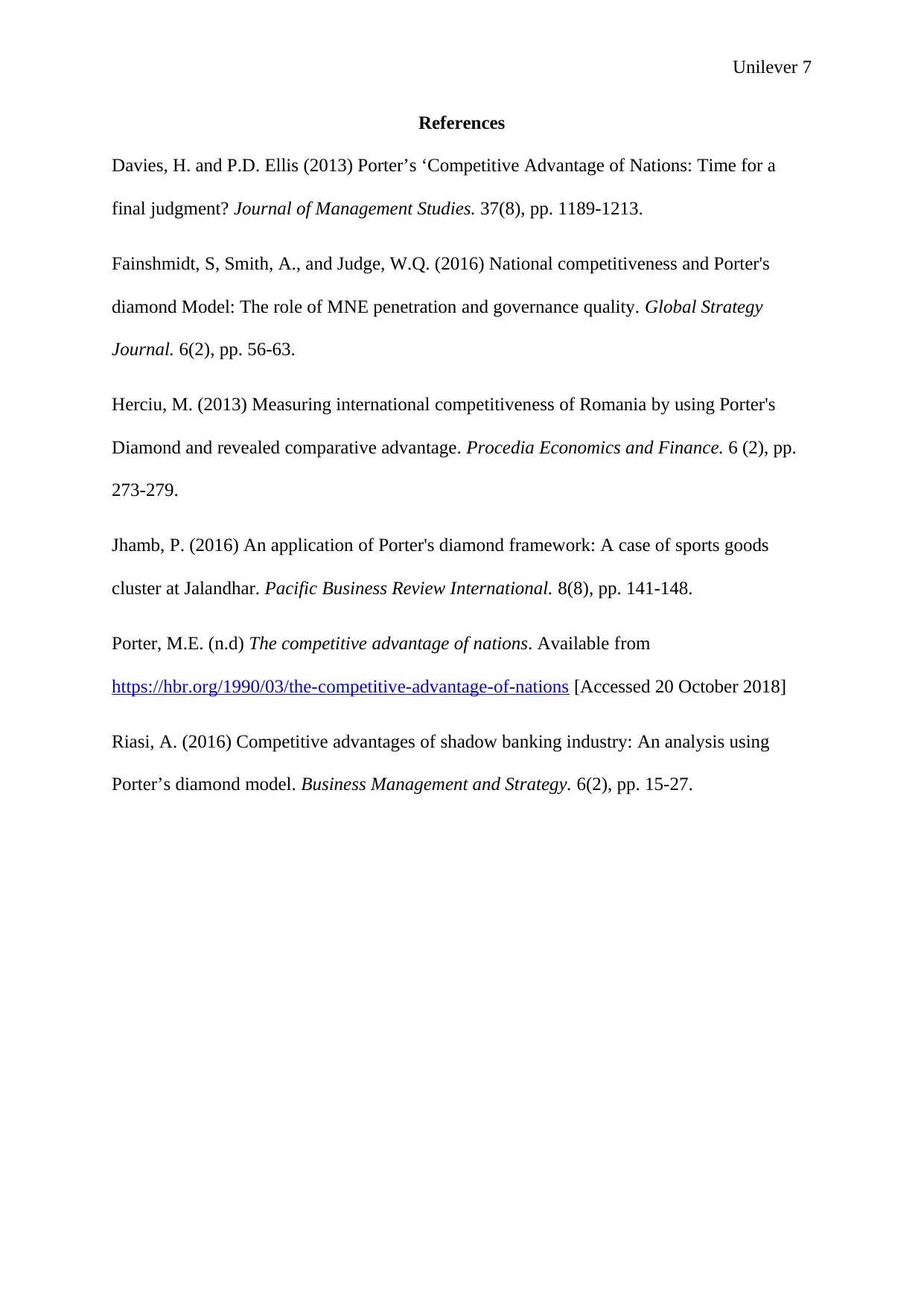
Unilever 7
References
Davies, H. and P.D. Ellis (2013) Porter’s ‘Competitive Advantage of Nations: Time for a
final judgment? Journal of Management Studies. 37(8), pp. 1189-1213.
Fainshmidt, S, Smith, A., and Judge, W.Q. (2016) National competitiveness and Porter's
diamond Model: The role of MNE penetration and governance quality. Global Strategy
Journal. 6(2), pp. 56-63.
Herciu, M. (2013) Measuring international competitiveness of Romania by using Porter's
Diamond and revealed comparative advantage. Procedia Economics and Finance. 6 (2), pp.
273-279.
Jhamb, P. (2016) An application of Porter's diamond framework: A case of sports goods
cluster at Jalandhar. Pacific Business Review International. 8(8), pp. 141-148.
Porter, M.E. (n.d) The competitive advantage of nations. Available from
https://hbr.org/1990/03/the-competitive-advantage-of-nations [Accessed 20 October 2018]
Riasi, A. (2016) Competitive advantages of shadow banking industry: An analysis using
Porter’s diamond model. Business Management and Strategy. 6(2), pp. 15-27.
References
Davies, H. and P.D. Ellis (2013) Porter’s ‘Competitive Advantage of Nations: Time for a
final judgment? Journal of Management Studies. 37(8), pp. 1189-1213.
Fainshmidt, S, Smith, A., and Judge, W.Q. (2016) National competitiveness and Porter's
diamond Model: The role of MNE penetration and governance quality. Global Strategy
Journal. 6(2), pp. 56-63.
Herciu, M. (2013) Measuring international competitiveness of Romania by using Porter's
Diamond and revealed comparative advantage. Procedia Economics and Finance. 6 (2), pp.
273-279.
Jhamb, P. (2016) An application of Porter's diamond framework: A case of sports goods
cluster at Jalandhar. Pacific Business Review International. 8(8), pp. 141-148.
Porter, M.E. (n.d) The competitive advantage of nations. Available from
https://hbr.org/1990/03/the-competitive-advantage-of-nations [Accessed 20 October 2018]
Riasi, A. (2016) Competitive advantages of shadow banking industry: An analysis using
Porter’s diamond model. Business Management and Strategy. 6(2), pp. 15-27.
1 out of 7
Related Documents
Your All-in-One AI-Powered Toolkit for Academic Success.
+13062052269
info@desklib.com
Available 24*7 on WhatsApp / Email
![[object Object]](/_next/static/media/star-bottom.7253800d.svg)
Unlock your academic potential
Copyright © 2020–2025 A2Z Services. All Rights Reserved. Developed and managed by ZUCOL.





